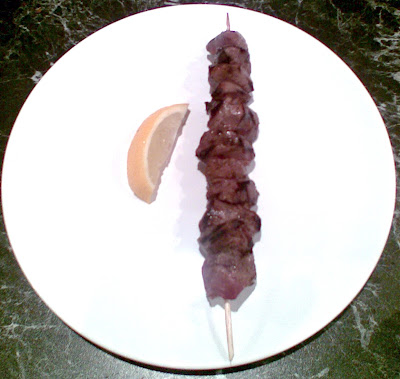 Jeg er glad i biff. Veldig glad i biff, og prøver å spise det så ofte jeg kan, som gjør at jeg nok snitter på nærmere en biff i uken de siste to årene. Små biffer er litt som klining, både kult og godt, men man er ikke veldig tilfredsstilt etterpå, og når jeg ikke kan komme på én anledning hvor jeg har gått fra bordet utilfredsstilt etter biff, har jeg nok spist mest store biffer. En gjennomsnittlig vekt á 350 g gjør at jeg har spist rundt 35 kilo entrecote de siste 104 ukene, eller ca 1/3 av min egen vekt. Det er litt skuffende lite egentlig. Allikevel er jeg så glad i biff, at jeg har blitt ønsket tillykke med fødselsdagen med ønske om at "dagen blir som en marmorert entrecote, saftig, smakfull og mør". Litt rart å ønske noen en mør dag, men avsenderen forsikret at det var ment godt, og det er vel tvilsomt om en seig dag ville vært å foretrekke.
Jeg er glad i biff. Veldig glad i biff, og prøver å spise det så ofte jeg kan, som gjør at jeg nok snitter på nærmere en biff i uken de siste to årene. Små biffer er litt som klining, både kult og godt, men man er ikke veldig tilfredsstilt etterpå, og når jeg ikke kan komme på én anledning hvor jeg har gått fra bordet utilfredsstilt etter biff, har jeg nok spist mest store biffer. En gjennomsnittlig vekt á 350 g gjør at jeg har spist rundt 35 kilo entrecote de siste 104 ukene, eller ca 1/3 av min egen vekt. Det er litt skuffende lite egentlig. Allikevel er jeg så glad i biff, at jeg har blitt ønsket tillykke med fødselsdagen med ønske om at "dagen blir som en marmorert entrecote, saftig, smakfull og mør". Litt rart å ønske noen en mør dag, men avsenderen forsikret at det var ment godt, og det er vel tvilsomt om en seig dag ville vært å foretrekke.Mange lager unødvendig mye tøys rundt kjøttet, poteter og sauser og mye annet rart, jeg pleier som regel å spise kjøttet med en enkel, litt bitter salat med vinaigrette, samt en sitronbåt å presse over kjøttet, men selv enkle og perfekte ting kan stundom velges bort. Slik som i går.
Av restauranter jeg gjerne skulle spist på, er Alinea i Chicago helt klart på listen. Jeg har aldri vært i Chicago, men har stedets tilhørende kokebok, en relativt komplisert affære, som samtidig er en gullgruve angående teknikker, teksturer og smakskombinasjoner. Gårsdagens komposisjon viste seg å være et fnugg fra den.
Jeg har laget en del salater basert på agurk, gjerne med et asiatisk tilsnitt, pekende mot Vietnam med fiskesaus, rått kjøtt og slikt, men de oppleves som en asiatisk salat, ikke som et biffmåltid. Denne retten klarer på en bemerekelsesverdig måte å forene smaker man hver for seg forbinder med Asia til en enhet som smaker svært bra, men som jeg har lite konnotasjoner til.
Mye av nøkkelen til at smakene ikke sauses inn i hverandre ligger i at soyasausen presenteres i en såpass fast form, brukt i original konsistens synes jeg soya ofte forkludrer maten og legger et slør over alle smakene.
Dette bør være nok til to.
Melon og agurksalat
1/2 agurk
1/4 honningmelon
Skall og saft av 1-2 lime
1 ss sukker
salt
Del melonen i fire, ta ut kjernene og skrell den. Del hvert segment i to på langs, og skjær 3 mm tykke skiver på tvers av denne (så de blir omtrent trapesformede). Skrell agurken og del i to på langs, skjær i like tyke skiver som melonen. Nå bør du ha skiver som er relativt form og størrelseslike (kongruente om du vil). Bland dem med limesaft og revet skall, sukker og salt, og la det stå i 15-20 min
Soyagele
125 g soyasaus
2 g agar agar
Kok opp soyasausen, ha i agar under omrøring. La småkoke i et minutt. Hell i en form og sett i kjøleskap til det er blitt kaldt og gele. Kjør denne geleen i en blender til den får en mousseaktig konsistens og fyll på en sprøyteflaske
Entrecote
Så mye entrecote du vil ha
Salt
Stek entrecoten, gjerne på grillen, til den er ferdig, dvs brun utenpå og rå inni. Hvis du synes at kjøttet skal være gjennomstekt bør du tenke nøye over livet ditt.
Når kjøttet er ferdig er det bare å anrette, melon og agurk om hverandre, små topper med soyagele oppå, kjøttet i skiver ved siden av. Ha evt litt ekstra av geleen rundt, på bildet ble det egentlig litt mye.










.jpg)
.jpg)
.jpg)
.jpg)
.jpg)